Abstract
Family and population studies indicate that predisposition to insulin-dependent (type I) diabetes mellitus (IDDM) is polygenic. It has been shown that the absence of the aspartic acid in position 57 (Asp57) of the DQ beta chain is positively correlated to IDDM. However, Asp57-negative haplotypes do not always confer susceptibility and conversely, some Asp57-positive haplotypes seem to be disease associated. It has been suggested that other HLA class II sequences, probably belonging to the HLA DQA1 gene, confer susceptibility to IDDM. This report, based on extensive oligonucleotide dot blot hybridization of PCR-amplified DQA1 and DQB1 genes, reinforces the importance of the Asp57-negative DQ beta chain, but also introduces the possibility that a DQ alpha chain bearing an arginine in position 52 (Arg52) confers susceptibility to IDDM. A molecular model of susceptibility to IDDM is proposed. This model strongly suggests that the disease susceptibility correlates quantitatively with the expression at the cell surface of a heterodimer, composed of a DQ alpha-chain bearing an Arg52 and a DQ beta chain lacking an Asp57. In view of the respective positions of the two residues and their charge, we might anticipate that both residues DQ beta Asp57 and DQ alpha Arg52 are critical for modulation of susceptibility, presumably via viral-antigenic peptide and/or autoantigen presentation.
Full text
PDF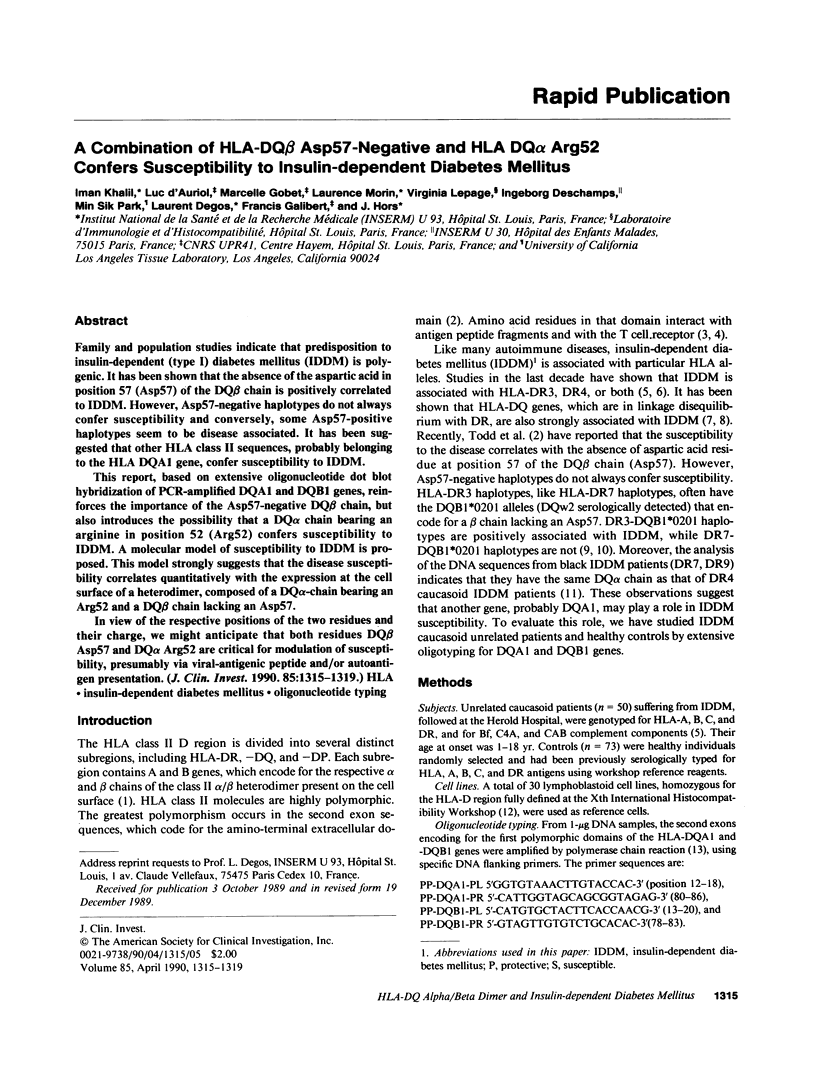
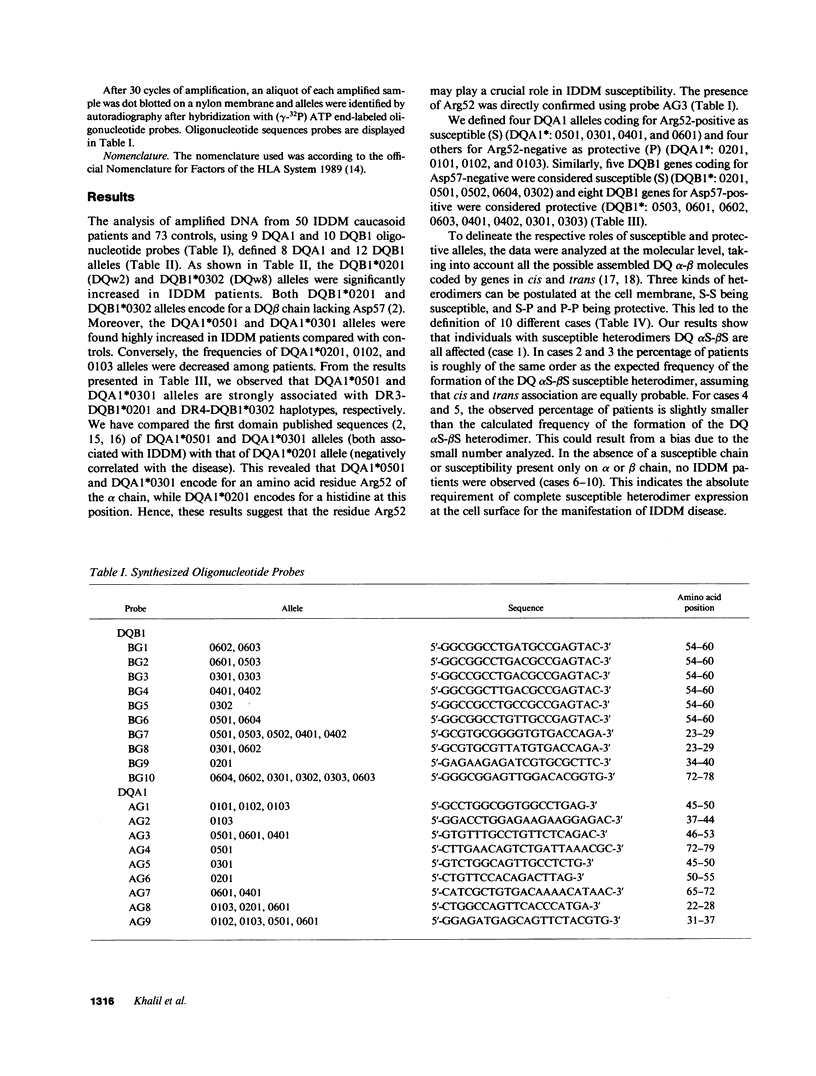
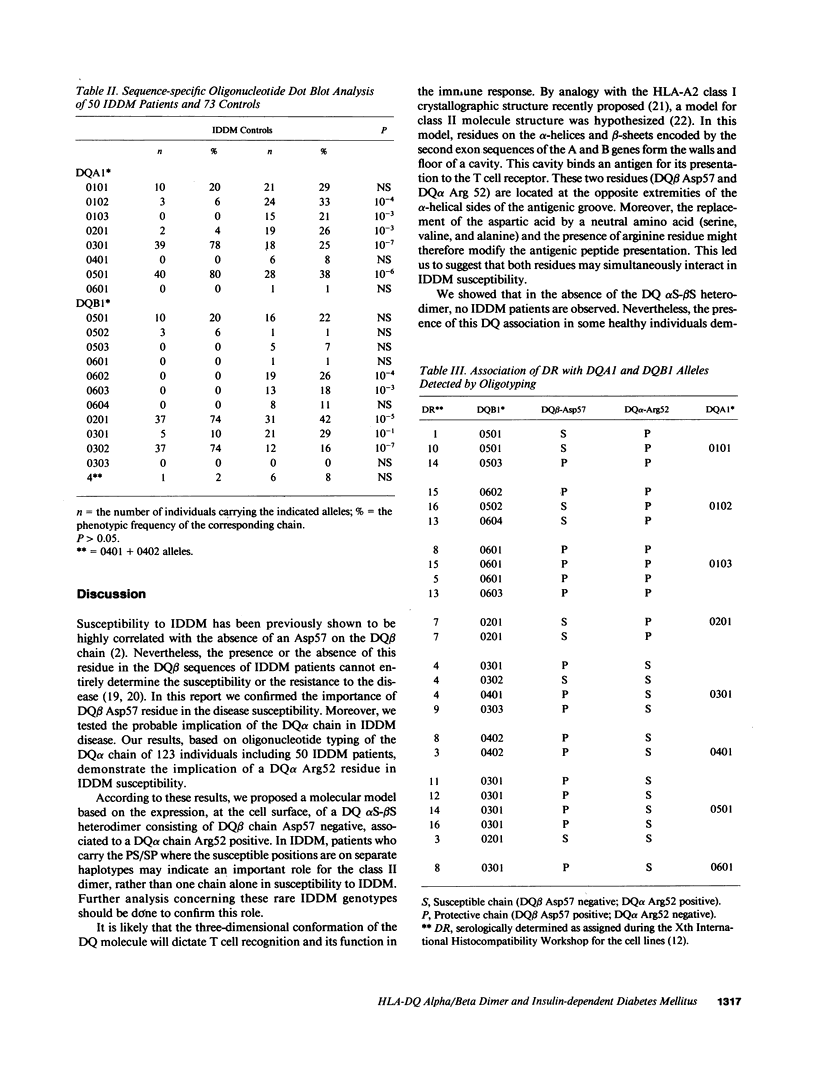
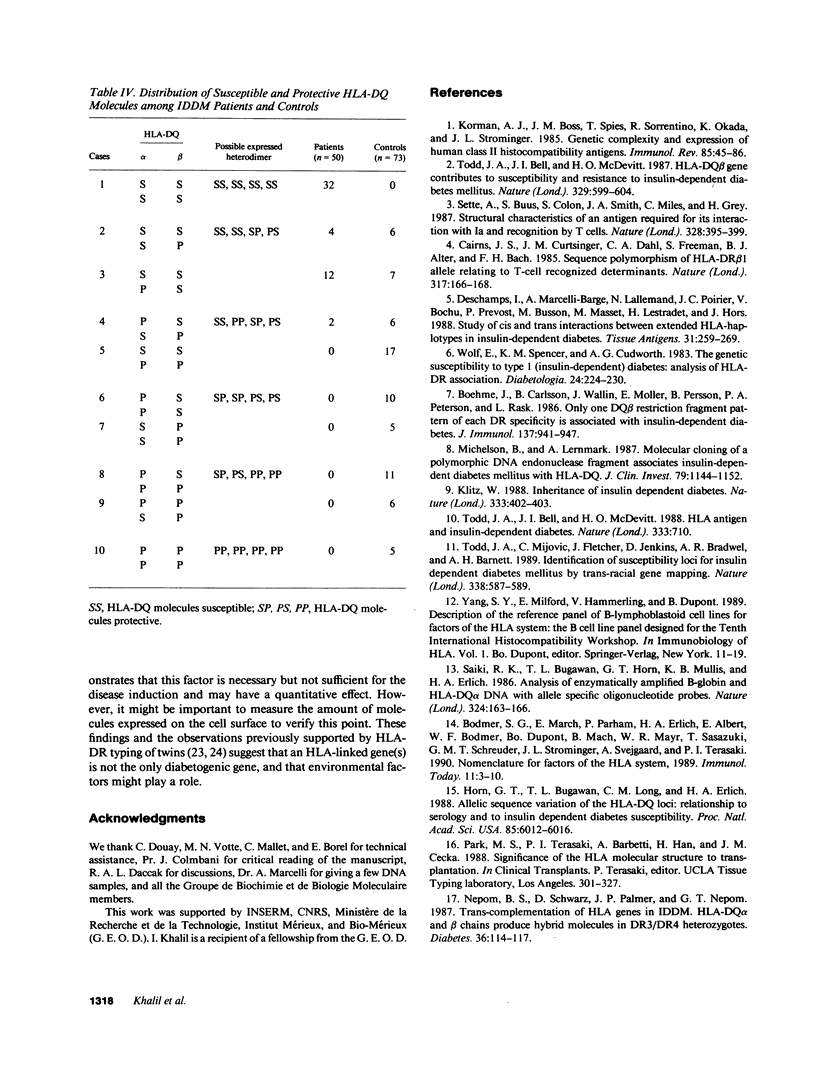
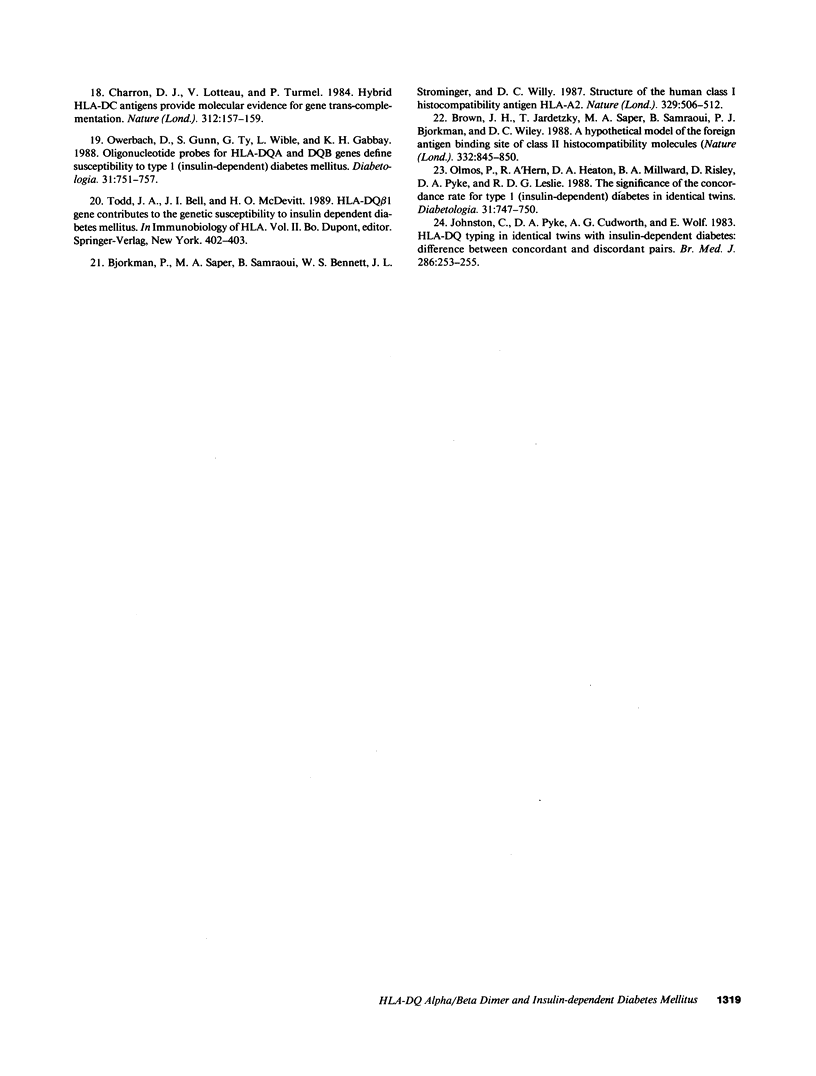
Selected References
These references are in PubMed. This may not be the complete list of references from this article.
- Bjorkman P. J., Saper M. A., Samraoui B., Bennett W. S., Strominger J. L., Wiley D. C. Structure of the human class I histocompatibility antigen, HLA-A2. Nature. 1987 Oct 8;329(6139):506–512. doi: 10.1038/329506a0. [DOI] [PubMed] [Google Scholar]
- Bjorkman P. J., Saper M. A., Samraoui B., Bennett W. S., Strominger J. L., Wiley D. C. The foreign antigen binding site and T cell recognition regions of class I histocompatibility antigens. Nature. 1987 Oct 8;329(6139):512–518. doi: 10.1038/329512a0. [DOI] [PubMed] [Google Scholar]
- Brown J. H., Jardetzky T., Saper M. A., Samraoui B., Bjorkman P. J., Wiley D. C. A hypothetical model of the foreign antigen binding site of class II histocompatibility molecules. Nature. 1988 Apr 28;332(6167):845–850. doi: 10.1038/332845a0. [DOI] [PubMed] [Google Scholar]
- Böhme J., Carlsson B., Wallin J., Möller E., Persson B., Peterson P. A., Rask L. Only one DQ-beta restriction fragment pattern of each DR specificity is associated with insulin-dependent diabetes. J Immunol. 1986 Aug 1;137(3):941–947. [PubMed] [Google Scholar]
- Cairns J. S., Curtsinger J. M., Dahl C. A., Freeman S., Alter B. J., Bach F. H. Sequence polymorphism of HLA DR beta 1 alleles relating to T-cell-recognized determinants. Nature. 1985 Sep 12;317(6033):166–168. doi: 10.1038/317166a0. [DOI] [PubMed] [Google Scholar]
- Charron D. J., Lotteau V., Turmel P. Hybrid HLA-DC antigens provide molecular evidence for gene trans-complementation. Nature. 1984 Nov 8;312(5990):157–159. doi: 10.1038/312157a0. [DOI] [PubMed] [Google Scholar]
- Deschamps I., Marcelli-Barge A., Lallemand N., Poirier J. C., Bochu V., Prévost P., Busson A., Massét M., Lestradet H., Hors J. Study of cis and trans interactions between extended HLA-haplotypes in insulin-dependent diabetes. Tissue Antigens. 1988 May;31(5):259–269. doi: 10.1111/j.1399-0039.1988.tb02093.x. [DOI] [PubMed] [Google Scholar]
- Horn G. T., Bugawan T. L., Long C. M., Erlich H. A. Allelic sequence variation of the HLA-DQ loci: relationship to serology and to insulin-dependent diabetes susceptibility. Proc Natl Acad Sci U S A. 1988 Aug;85(16):6012–6016. doi: 10.1073/pnas.85.16.6012. [DOI] [PMC free article] [PubMed] [Google Scholar]
- Johnston C., Pyke D. A., Cudworth A. G., Wolf E. HLA-DR typing in identical twins with insulin-dependent diabetes: difference between concordant and discordant pairs. Br Med J (Clin Res Ed) 1983 Jan 22;286(6361):253–255. doi: 10.1136/bmj.286.6361.253. [DOI] [PMC free article] [PubMed] [Google Scholar]
- Klitz W. Inheritance of insulin-dependent diabetes. Nature. 1988 Jun 2;333(6172):402–403. doi: 10.1038/333402c0. [DOI] [PubMed] [Google Scholar]
- Korman A. J., Boss J. M., Spies T., Sorrentino R., Okada K., Strominger J. L. Genetic complexity and expression of human class II histocompatibility antigens. Immunol Rev. 1985 Jul;85:45–86. doi: 10.1111/j.1600-065x.1985.tb01130.x. [DOI] [PubMed] [Google Scholar]
- Michelsen B., Lernmark A. Molecular cloning of a polymorphic DNA endonuclease fragment associates insulin-dependent diabetes mellitus with HLA-DQ. J Clin Invest. 1987 Apr;79(4):1144–1152. doi: 10.1172/JCI112931. [DOI] [PMC free article] [PubMed] [Google Scholar]
- Nepom B. S., Schwarz D., Palmer J. P., Nepom G. T. Transcomplementation of HLA genes in IDDM. HLA-DQ alpha- and beta-chains produce hybrid molecules in DR3/4 heterozygotes. Diabetes. 1987 Jan;36(1):114–117. doi: 10.2337/diab.36.1.114. [DOI] [PubMed] [Google Scholar]
- Olmos P., A'Hern R., Heaton D. A., Millward B. A., Risley D., Pyke D. A., Leslie R. D. The significance of the concordance rate for type 1 (insulin-dependent) diabetes in identical twins. Diabetologia. 1988 Oct;31(10):747–750. doi: 10.1007/BF00274777. [DOI] [PubMed] [Google Scholar]
- Owerbach D., Gunn S., Ty G., Wible L., Gabbay K. H. Oligonucleotide probes for HLA-DQA and DQB genes define susceptibility to type 1 (insulin-dependent) diabetes mellitus. Diabetologia. 1988 Oct;31(10):751–757. doi: 10.1007/BF00274778. [DOI] [PubMed] [Google Scholar]
- Saiki R. K., Bugawan T. L., Horn G. T., Mullis K. B., Erlich H. A. Analysis of enzymatically amplified beta-globin and HLA-DQ alpha DNA with allele-specific oligonucleotide probes. Nature. 1986 Nov 13;324(6093):163–166. doi: 10.1038/324163a0. [DOI] [PubMed] [Google Scholar]
- Sette A., Buus S., Colon S., Smith J. A., Miles C., Grey H. M. Structural characteristics of an antigen required for its interaction with Ia and recognition by T cells. 1987 Jul 30-Aug 5Nature. 328(6129):395–399. doi: 10.1038/328395a0. [DOI] [PubMed] [Google Scholar]
- Todd J. A., Bell J. I., McDevitt H. O. HLA antigens and insulin-dependent diabetes. Nature. 1988 Jun 23;333(6175):710–710. doi: 10.1038/333710a0. [DOI] [PubMed] [Google Scholar]
- Todd J. A., Bell J. I., McDevitt H. O. HLA-DQ beta gene contributes to susceptibility and resistance to insulin-dependent diabetes mellitus. Nature. 1987 Oct 15;329(6140):599–604. doi: 10.1038/329599a0. [DOI] [PubMed] [Google Scholar]
- Todd J. A., Mijovic C., Fletcher J., Jenkins D., Bradwell A. R., Barnett A. H. Identification of susceptibility loci for insulin-dependent diabetes mellitus by trans-racial gene mapping. Nature. 1989 Apr 13;338(6216):587–589. doi: 10.1038/338587a0. [DOI] [PubMed] [Google Scholar]
- Wolf E., Spencer K. M., Cudworth A. G. The genetic susceptibility to type 1 (insulin-dependent) diabetes: analysis of the HLA-DR association. Diabetologia. 1983 Apr;24(4):224–230. doi: 10.1007/BF00282704. [DOI] [PubMed] [Google Scholar]


